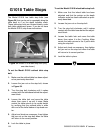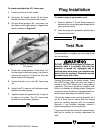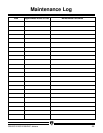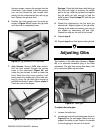
G0500/G1018/G1018HW 8" Jointers -31-
Edge Jointing
The purpose of edge jointing is to produce a fin-
ished, flat-edged surface that is suitable for join-
ery or finishing. It is also a necessary step in the
squaring process of rough or warped stock. See
Figure 46.
Figure 46. Illustration of edge jointing effects.
To edge joint on the jointer:
1. Make sure that you have read and under-
stand all safety instructions in Section 1:
Safety and that your stock has been inspect-
ed for safe operation as described in the
“Stock Inspection” instructions earlier in this
section.
2. Make sure your workpiece is within the mini-
mum and maximum stock dimensions that
your Grizzly 8" Jointer can safely process.
(Check the data sheet in the back of this
manual for your particular model.)
3. Set the cutting depth for your operation. (We
suggest between
1
⁄16" and
1
⁄8" for edge joint-
ing, using a more shallow depth for harder
wood species or for wider stock.)
4. Make sure the fence is set to 90˚.
5. If your workpiece is cupped (warped), place
it so the concave side is face down on the
surface of the infeed table.
6. Start the jointer.
7. Press the workpiece against the table and
fence with firm pressure. Use your trailing
hand to guide the workpiece through the cut.
8. Feed the workpiece over the cutterhead as
shown in Figure 47. Note—If your leading
hand gets within 4" of the cutterhead, lift it up
and over the cutterhead, and place it on the
portion of the workpiece that is over the out-
feed table. At this point, focus your pressure
on the outfeed end of the workpiece while
feeding, and repeat the same action with
your trailing hand when it gets within 4" of
the cutterhead. To keep your hands safe,
DO NOT let them get closer than 4" from the
cutterhead when it is moving!
9. Repeat steps 7-8 until the entire edge is flat.
Figure 47. Edge jointing a
workpiece.
NOTICE
If you are not experienced with a jointer, set
the depth of cut to 0", and practice feeding
the workpiece across the tables as
described below. This procedure will better
prepare you for the actual operation.


















